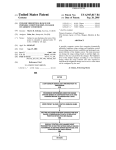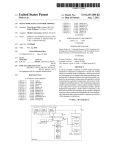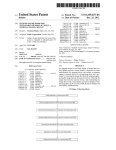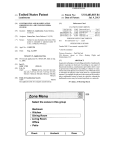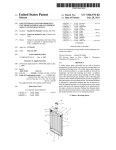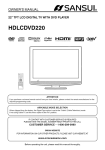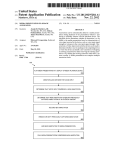Download Clearing potentially inadvertent entries in electronic device
Transcript
US007924268B2
(12) Unlted States Patent
(10) Patent N0.2
Kavounas
(54)
(75)
(45) Date of Patent:
CLEARING POTENTIALLY INADVERTENT
5,991,396 A *
11/1999 Salm et a1. .................. .. 715/860
5,995,844 A
6,567,672 B1
11/ 1999 Fukuda
5/2003 Park et a1.
6,630,927 B2
10/2003
Inventor:
.
Gregory T. Kavounas, KIrkland, WA
6,731,312 B2
Assignee: Frobisher Fulton PA L.L.C., Dover, DE
(US)
.
Not1ce:
.
.
.
6,867,763 B2*
3/2005 Grif?n et a1. ............... .. 345/168
6,947,771 B2
9/2005 Guo et a1.
7,099,684 B2
8/2006 Cowsky et al.
7,256,769 B2*
8/2007 Pun et a1. .................... .. 345/171
2002/0190962
6/2008 Grif?n
12/2002
Miura
345/169
.......... ..
2004/0204123 A1 * 10/2004 Cowsky et al‘
patent 15 extended or adjusted under 35
2005/0116840 A1*
345/173
455/565
6/2005 Simelius ..................... .. 345/168
FOREIGN PATENT DOCUMENTS
Appl. No.: 11/270,972
JP
_
01100619 A * 4/1989
* cited by examiner
(22) Flled:
Nov. 10, 2005
(65)
Prior Publication Data
May
Us
Primary Examiner * Chanh Nguyen
Assistant Examiner i
J Snyder
(74) Attorney, Agent, or Firm * Fitch Even Tabin &
’
(51) Int. Cl.
Flannery
G06F 3/02
(52)
(58)
A1*
Subject to any d1scla1mer, the term ofth1s
U.S.C. 154(b) by 894 days.
(21)
Sherman et a1.
5/2004 Robbin
7,382,359 B2*
.
(*)
Apr. 12, 2011
ENTRIES IN ELECTRONIC DEVICE
(US)
(73)
US 7,924,268 B2
(2006.01)
U:S.Cl. ...... .... ...... ... .................................... .. 345/169
FIeld of ClassI?catIon Search ................ .. 345/156,
(57)
345/ 168*172; 455/565; 341/22i34
See application ?le fOr complete SBarCh hiSIOI‘y-
Electronic devices, software and methods for a host elec
tronic device such as a mobile phone, PDA, player, etc. In
_
(56)
ABSTRACT
some embodiments, a criterion is used to determine whether
References Clted
a manual entry by the user was intended. If not, the entry is
cleared.
US. PATENT DOCUMENTS
4,859,100 A
5,987,311 A
8/1989 Carlson et a1.
11/1999 Phillips
35 Claims, 4 Drawing Sheets
5%
—D|
m RECEIVE MANUAL ENTRY
l
m
I
GENERATE USER SIGNAL FROM MANUAL ENTRY I
$39
MANUAL ENTRY INADVERTENT?
I
5A0,
APPLY USER SIGNAL
TO REGULAR USE
I
|
£0
CLEAR USER SIGNAL (NO REGULAR USE)
I
i
|
l4—
NO
26.0
PRIOR ENTRY RECEIVED?
YES
l
5:“)
CLEAR USER SIGNAL OF PRIOR ENTRY 1
US. Patent
Apr. 12, 2011
Sheet 1 014
US 7,924,268 B2
14 2
'1—42
WAS
INTENTIONAL?
1_Q
PROCESSOR
USER INPUT
INTERFACE
09
fg)
r ____ “I
(E.G. KEYS,
KEYPAD,
{ 111$ :
: TIMER :
WHEEL, ETC.)
————— —~
SET OF COMPONENTS OF HOST ELECTRONIC DE VICE
FIGURE 1
200
280
220
HOSTDEVICE IS
FIGURE 2
@M
US. Patent
Apr. 12, 2011
Sheet 2 014
US 7,924,268 B2
300
380
320
FIGURE 3
HOST DEVICE IS PDA
400
HOST DE VICE IS PLAYER
FIGURE 4
US. Patent
———>
Apr. 12, 2011
m
Sheet 3 014
US 7,924,268 B2
RECEIVE MANUAL ENTRY
I
m MO
GENERATE USER SIGNAL FROM MANUAL ENTRY
?
MANUAL ENTRY INA DVERTENT?
540
CLEAR USER SIGNAL (NO REGULAR USE)
M
PRIOR ENTRY RECEIVED?
?
FIGURE 5
CLEAR USER SIGNAL OF PRIOR ENTRY
APPLY USER SIGNAL
TO REGULAR USE
US. Patent
Apr. 12, 2011
Sheet 4 014
US 7,924,268 B2
@
mu:
m EMBODIMENT or
IIWEN'I'IUH:
n
1‘:
rs
T4
T5
m
1':
T8
T9
[as n]
T10
scum:
mr usnn sms
snows
(mum LOOKING]
masnm
I _ _ _ \
1111ch
i
1
\ _. .. .._ 1
G
.
5mm:
LOOKINGAT
" _ - _\
m;ch
\ _ _ _ 2
HDTLUOKING;
r '- - ~\
mmwzn'nzm
I
1:an("4")
‘" - - - 4'
W shuns memn'ro
nn'r LOOKING;
4 ;
, - - -\
SEEIF "4"
I
4 ‘
manwnmm
\ .. .. _ 1
STOPS mum
I ._ _ _ ‘
muvnnnzm
|
11an ("1")
\ __ __ _ ,1
m sums mmn'ro
, _ _ _
sum "1"
|
111111111;an
\ _ _ _ ,1
m mum ’I'IJ'IIEDUT?O,
HoTLooan;
41 1
41 I
I _ _ _
"1" manvnnmm;
I
4 i
cums "1"
\ _ _ _ 1
cLEmn "1"; so, "4"
z - - -\
use mmvnnmm;
i
cums "4"
\ - - - 1
;
LonKs AT
, _ _ - \
nnvmz; ITIS
l
READY
\ .. .. .. .1'
[mums as
, _ _ _
mmnnnn]
l
;
G
1206 1
\___1
FIGURE 6
SAMPLE CLEARING‘OPERATIONS
US 7,924,268 B2
1
2
FIG. 2 is a perspective diagram of a wireless cellular tele
CLEARING POTENTIALLY INADVERTENT
ENTRIES IN ELECTRONIC DEVICE
phone hosting the set of components of FIG. 1 according to
embodiments.
FIG. 3 is a perspective diagram of a Personal Digital Assis
tant hosting the set of components of FIG. 1 according to
embodiments.
FIG. 4 is a perspective diagram of an electronic player
hosting the set of components of FIG. 1 according to embodi
BACKGROUND
1. Field of the Invention
The present invention is related to the ?eld of portable
electronic devices such as cellular telephones, personal digi
tal assistants (PDAs), players such as music players and game
players, and the like, and more speci?cally to such devices
that have an interface for manual entries by the user, and
ments.
FIG. 5 is a ?owchart illustrating method according to
embodiments.
FIG. 6 is a table for explaining a sample operation of the set
of components of FIG. 1 according to an embodiment.
further features for reacting to user entries that were poten
tially inadvertent.
2. Description of the Related Art
Portable electronic devices such as cell phones, personal
DETAILED DESCRIPTION
digital assistants, players, and the like are proliferating.
Increasingly, people carry them on their persons for ease of
As has been mentioned, the present invention provides
use.
devices, software and methods for electronic devices. The
Many of these devices have interfaces for the user to make
entries. A typical such interface is a keypad. For example,
personal digital assistants have keypads for entering charac
invention is now described in more detail.
ters, along with other controls. For another example, cellular
Referring now to FIG. 1, a block diagram is now described
for a set 100 of operational components of a host electronic
telephones (“cell phones” or “mobile telephones”) have key
pads for dialing numbers, along with activation keys (that
device (not shown in FIG. 1), which is made according to
embodiments. A host electronic device having components
effectuate dialing and other functions). Other devices, such as
iPOD-type players, have rotary interfaces, and so on.
20
25
A problem with such interfaces is that entries can be
received inadvertently, from movements of the user. For
Set 100 includes a user interface 120. Interface 120 is
adapted to receive manual entries ME by movements of a
user. In addition, interface 120 is adapted to generate electri
cal user signals US responsive to receiving entries ME. User
example, when someone wears a cell phone on their person,
they might later discover from the screen that certain buttons
have been pressed inadvertently. They must then clear the
inadvertent entries. It is even more of a problem when an
30
activation key has been pressed inadvertently. For example, if
it is a telephone, an inadvertently dialed number has been
called.
Some solutions have been proposed for preventing inad
vertently manual entries. For example, US. Pat. No. 4,859,
100 provides a keypad with partitions between the keys. This
35
password needs to be dialed ?rst. Examples of these include
US. Pat. Nos. 6,630,927, and 5,987,311.
Users can grow impatient when they are required to take
more steps, and even neglect to take them. After all, taking
more steps is just what they had to do to clear the inadvertent
signals US are designed to be applied to corresponding regu
laruses of the host device, such as for entering data, activating
the device, and so on.
Interface 120 can be made any number of ways, examples
of which will be described in more detail below. In many
embodiments, interface 120 has one or more pushbuttons. In
some embodiments, a number of the pushbuttons can be
arranged in a keypad. In some embodiments, interface 120
includes a joystick. In some embodiments, interface 120
can require more space to implement the keypad.
Others of these solutions have required users to take more
steps. For example, a manual cover over a keypad can be
opened. Or a soft lock feature can be implemented, where a
100 can be implemented in any number of applications, as
will be seen from the examples below.
includes a wheel. Sometimes the wheel canbe turned to scroll
40
quickly through possible entries.
Set 100 also includes a processor 140, provided as per the
invention. Processor 140 receives via interface 120 user sig
nals US that correspond to the manual entries ME of the user.
In some embodiments it is also advantageous but not neces
45
sary that processor 140 is also the same processor as the one
provided for implementing the regular functions of the host
device, e.g. in response to regularly receiving the user signals
entries anyway.
US from interface 120. Whether a processor as per the inven
BRIEF SUMMARY
tion, or also implementing the regular functions of the host
The present invention overcomes these problems and limi
tations of the prior art.
50
device, processor 140 can be made in any way known in the
Generally, the present invention provides electronic
art. Examples only include a general-purpose processor that
is specially programmed, or a dedicated processor, imple
devices, software and methods for electronic devices. In some
embodiments, manual entries by the user are cleared, if it
mented in one or more units. The end result for processor 140
is a microcontroller, or a microprocessor, or a Digital Signal
becomes determined that they were potentially inadvertent.
Some embodiments offer the advantage that such entries
55
Processor (DSP), or a Floating Point Gate Array, or anAppli
cation Speci?c Integrated Circuit (ASIC), etc.
are cleared without the user needing to take more steps. In
Processor 140 determines whether manual entry ME was
fact, sometimes clearing can be discreet, without the user
intentional. The determination is depicted conceptually by a
thought shape 142 in FIG. 1. If it is determined that indeed
even ?nding out.
The invention will become more readily apparent from the
60
following Detailed Description, which proceeds with refer
ence to the drawings, in which:
BRIEF DESCRIPTION OF THE DRAWINGS
65
FIG. 1 is a block diagram of a set of operational compo
nents of a host electronic device according to embodiments.
manual entry ME was intentional, user signals US are applied
to their regular use for the host device.
Processor 140 of course cannot read the mind of the user, to
determine whether their movement that resulted in manual
entry ME was intentional or not. Therefore, processor 140
makes this determination by any number of criteria. There can
be many such criteria according to the invention. In a number
of embodiments, the criteria are chosen so that they infer the
US 7,924,268 B2
4
3
probable mindset of the user at the time of the movement that
resulted in the manual entry ME.
One such criterion is that enough time passes from a
gram to execute. In other embodiments, at least a portion of its
program is stored in memory 160. In some embodiments,
manual entry ME, without anything else happening. If so, the
memory 160 provided for storing the programs of processor
In some embodiments, processor 140 stores its own pro
manual entry ME can be deemed inadvertent, not intentional,
140 is also the same memory as the one provided for imple
and it can be inferred that the user did not have an intention to
menting other functions of the host device.
actually use the device. There are a number of ways of imple
menting such a criterion.
In some embodiments, processor 140 includes an optional
timer 144, which can determine whether a timeout period
In addition, in some embodiments, memory 160 can store
parameters relating to operation of the invention. For
example, memory 160 can store a record corresponding to the
?rst manual entry. When the ?rst signal is cleared, however,
expires. The timeout period can be measured starting from
the record is erased from the memory.
Set 100 also optionally includes a screen 180 for viewing
by the user. Screen 180 may be implemented in any way
known in the art for such host electronic devices.
any number of events, such as when the entry ME was made,
or the user signal US was generated. A good duration for the
timeout period would be 30 seconds.
Additional extensions of the invention include the feature
and method of setting the duration of the timeout period, or
In some embodiments, screen 180 can show images corre
sponding to the manual entries ME received via interface 120.
When the ?rst signal is cleared, however, the images are
adjusting it. In some embodiments, the user can be prompted
to adjust the timeout duration. In some embodiments, the user
erased from screen 180.
In some of those embodiments, screen 180 can also convey
can even disable the feature.
In yet more embodiments, the host device can learn from
habitual behaviors of the user, and adjust the duration. One
objective of such automatic adjusting can be for the operation
of the invention to remain discreet and unobtrusive.
Another such criterion is that a previous entry ME was
20
operations of the invention. For example, it can convey
prompts that an entry is going to be cleared, and that the user
should react. The prompt can be that the shown image is
?ashing, it can include a countdown, and so on.
The host device (not shown in FIG. 1) for set 100 of
deemed inadvertent. The rationale is that the user can make a 25 components can be implemented in any number of ways for
number of inadvertent entries ME; if the last one is found
inadvertent, then all the prior ones can be so found, since the
last reset. So, they can be cleared all at once, or equivalently
one at a time. It should be noted from this example is that
different criteria can be applied to different entries from a
30
group of even successive entries.
One more such criterion is that a number of successive
pad with pushbuttons. Interface 220 operates similarly to the
above-described interface 120. Telephone 200 also has a
entries are the same, especially if they are the last received.
For example, a pushbutton may be pushed for a long time,
causing the same entry to be made a number of times. That
can be deemed unintentional in a number of instances, such as
when a telephone number is to be dialed.
35
Telephone 200 also includes a processor (not shown) simi
is particularly advantageously applied where the ?rst regular
40
Activating could be for the host device to generate a wireless
transmission, which can encode a telephone number that is to
be dialed, or a network address that is to be accessed. The
con?rmation can be by issuing another prompt to the user and
so on.
Moreover, criteria can be made by combining one or more
of the above criteria. For example, when two or more similar
entries are received successively, a timeout period can be
waited for. Further, since these are more likely inadvertent
than a single entry, the duration can be shortened, and so on.
45
lar to processor 140 of set 100, or is otherwise capable of
performing methods of the invention, or both. This way tele
phone 200 can determine whether some of the manual entries
in interface 220 were inadvertent, and if so clear them.
FIG. 3 is a perspective diagram of a Personal Digital Assis
tant (PDA) 300. PDA 300 is the host electronic device for set
100 of the components of FIG. 1, according to embodiments.
PDA 300 has an interface 320, which can include pushbut
tons and/or other controls. Interface 320 operates similarly to
the above-described interface 120. PDA 300 also has a screen
380 similarly to the above-described screen 180. In some
50
Regardless of how a manual entry ME is deemed inadvert
ent, processor 140 can clear its corresponding user signal US.
embodiments, the user’s manual entries that are received in
interface 320 are echoed in screen 380, by corresponding
images.
Clearing is such that user signal US is prevented from being
applied to the regular use. Clearing can be further imple
mented in a number of additional ways, such as described
screen 280 similarly to the above-described screen 180. In
some embodiments, the user’s manual entries that are
received in interface 220 are echoed in screen 280, by corre
sponding images.
Yet one more criterion can be to request con?rmation. This
use is to activate the device, beyond merely dialing numbers.
any number of functions. Some non-limiting examples are
now described, to demonstrate the wide array of applications.
FIG. 2 is a perspective diagram of a wireless cellular tele
phone 200. Telephone 200 is the host electronic device for set
100 of the components of FIG. 1, according to embodiments.
Telephone 200 has an interface 220, which includes a key
55
PDA 300 also includes a processor (not shown) similar to
processor 140 of set 100, or is otherwise capable of perform
ing methods of the invention, or both. This way, PDA 300 can
later in this document.
In some embodiments, set 100 is adapted to perform a
determine whether some of the manual entries in interface
320 were inadvertent, and if so clear them.
number of additional operations before clearing the entries
FIG. 4 is a perspective diagram of an electronic player 400.
Player 400 is the host electronic device for set 100 of the
that have been deemed inadvertent. For example, it can issue
a warning prompt to the user prior to clearing, to the effect
60
components of FIG. 1, according to embodiments. Player 400
that clearing is impending. The prompt could give a deadline
can be, for example, an electronic music player, such as an
for the user to react, such as by making another entry. If not,
MP3 music player. Or player 400 can be a game playing
clearing can be performed responsive to the deadline expir
device, and so on.
ing. The deadline can be expressed as a countdown.
Set 100 also optionally includes a memory 160. Memory
1 60 may be implemented in any way known in the art for such
host electronic devices.
65
Player 400 has an interface 420, which can include a wheel,
pushbuttons, and so on. Interface 420 operates similarly to the
above-described interface 120. Player 400 also has a screen
480 similarly to the above-described screen 180.
US 7,924,268 B2
5
6
Player 400 also includes a processor (not shown) similar to
processor 140 of set 100, or is otherwise capable of perform
ing methods of the invention, or both. This way, player 400
any event, the software modules or features of this description
may be implemented by themselves, or in combination with
others. Even though it is said that the program may be stored
can determine whether some of the manual entries in interface
420 were inadvertent, and if so clear them.
in a computer-readable medium, it should be clear to a person
skilled in the art that it need not be a single memory, or even
a single machine. Various portions, modules or features of it
may reside in separate memories, or even separate machines.
Moreover, methods are described below. The methods and
algorithms presented herein are not necessarily inherently
associated with any particular computer or other apparatus.
Rather, various general-purpose machines may be used with
programs in accordance with the teachings herein, or it may
The separate machines may be connected directly, or through
a network, such as a local access network (LAN), or a global
network, such as the Internet.
It will be appreciated that some of these methods may
prove more convenient to construct more specialized appara
tus to perform the required method steps. The required struc
include software steps which may be performed by different
ture for a variety of these machines will become apparent
modules of an overall parts of a software architecture. For
from this description.
example, data forwarding in a router may be performed in a
data plane, which consults a local routing table. Collection of
performance data may also be performed in a data plane. The
performance data may be processed in a control plane, which
In all cases there should be borne in mind the distinction
between methods in this description, and the method of oper
ating a computing machine such as electronic device 100.
This description relates both to methods in general, and
also to steps for operating a device and for processing elec
trical or other physical signals to generate other desired physi
accordingly may update the local routing table, in addition to
20
neighboring ones. A person skilled in the art will discern
cal signals.
which step is best performed in which plane.
Programs are additionally included in this description, as
are methods of operation of the programs. A program is
An economy is achieved in the present document in that a
single set of ?owcharts is used to describe both programs, and
also methods. So, while ?owcharts are described in terms of
boxes that depict operations, they can mean both method and
programs.
generally de?ned as a group of steps leading to a desired
result, due to their nature and their sequence. A program is
usually advantageously implemented as a program for a com
puting machine, such as a general-purpose computer, a spe
cial purpose computer, a microprocessor, etc.
Storage media are additionally included in this description.
Such media, individually or in combination with others, have
25
For this description, the methods may be implemented by
machine operations. In other words, embodiments of pro
grams are made such that they perform methods of the inven
30
stored thereon instructions of a program made according to
tion that are described in this document. These may be option
ally performed in conjunction with one or more human
the invention. A storage medium according to the invention is
operators performing some, but not all of them. As per the
a tangible computer-readable medium, such as a memory, and
above, the users need not be collocated with each other, but
each only with a machine that houses a portion of the pro
gram. Altemately, some of these machines may operate auto
matically, without users and/ or independently from each
other.
is read by the computing machine mentioned above.
Performing the steps or instructions of a program requires
35
physical manipulations of physical quantities. Usually,
though not necessarily, these quantities may be transferred,
combined, compared, and otherwise manipulated or pro
cessed according to the instructions, and they may also be
stored in a computer-readable medium. These quantities
Methods of the invention are now described.
40
Referring now to FIG. 5, a ?owchart 500 is used to illus
trate a method according to another embodiment of the inven
include, for example electrical, magnetic, and electromag
tion. The method of ?owchart 500 may also be practiced by
netic signals, and also states of matter that can be queried by
such signals. It is convenient at times, principally for reasons
of common usage, to refer to these quantities as bits, data bits,
telephone 200, PDA 300, player 400, and so on.
According to an operation 510, a manual entry ME is
samples, values, symbols, characters, images, terms, num
set 100, and any electronic device that hosts set 100, such as
45 received from a user. This can be in an interface 120 as
described above, and could be inadvertent, meaning not
bers, or the like. It should be borne in mind, however, that all
of these and similar terms are associated with the appropriate
physical quantities, and that these terms are merely conve
nient labels applied to these physical quantities, individually
or in groups.
50
This detailed description is presented largely in terms of
?owcharts, display images, algorithms, and symbolic repre
sentations of operations of data bits within at least one com
puter readable medium, such as a memory. Indeed, such
descriptions and representations are the type of convenient
labels used by those skilled in programming and/or the data
processing arts to effectively convey the substance of their
55
intended by the user.
According to a next operation 520, a user signal US is
generated from manual entry ME. This can be from interface
120 as described above. As also per the above, user signal US
is intended for a regular use by the host device, if the entry is
intended.
According to a next operation 530, it is determined whether
manual entry ME was inadvertent. In other words, whether it
was performed according to a corresponding intention of the
user. This determining is performed according to one or more
criteria, such as described above.
work to others skilled in the art. A person skilled in the art of
If at operation 530 it is determined that manual entry ME
programming may use these descriptions to readily generate
speci?c instructions for implementing a program according
was intended, then in some embodiments according to a next
60
to the present invention.
Often, for the sake of convenience only, it is preferred to
implement and describe a program as various interconnected
distinct software modules or features, individually and col
lectively also known as software. This is not necessary, how
ever, and there may be cases where modules are equivalently
aggregated into a single program with unclear boundaries. In
operation 540, the user signal is applied to the regular use.
This means that the host device operates regularly form the
manual entry ME.
If at operation 530 it is determined that manual entry ME
was inadvertent, then in some embodiments according to a
65
next operation 550, the user signal US is cleared. This means
that it is not applied to the regular use described in connection
with operation 540. Clearing can be performed in a number of
US 7,924,268 B2
8
7
At a later time T9, the user looks again at the screen. What
ways, such as described above. In addition, operations can be
performed to warn the user that clearing is impending, such as
described above.
they see is the regular standby message, such as at time T2.
They may be unaware that they made inadvertent entries, and
that the host device cleared them.
At a later time T1 0, the user uses the host device, by making
entries as intended. For example, they could be dialing a
According to an optional operation 560, it is inquired
whether a prior entry has been received. It is preferred that all
prior such entries are counted since the last reset activity,
telephone number.
which returned the host electronic device to a standby status.
If no prior entry has been received, then execution returns to
A difference should be ob served over the prior art. Without
the embodiment of the invention of this example, when at T9
the user looked again, they would have seen instead the screen
of time T6. Then they would have to take an extra step to clear
it.
A person skilled in the art will be able to practice the
operation 510.
If at operation 560 a prior entry has been received, then
according to an optional next operation 570, the prior entry
and/ or its user signal is cleared. Then execution can return to
operation 560, to clear additional prior entries.
present invention in view of the description present in this
FIG. 6 is a table 600 for explaining a sample operation of
set 100 of the components of a host device, according to an
embodiment of ?owchart 500. Table 600 has rows showing
document, which is to be taken as a whole. Numerous details
have been set forth in order to provide a more thorough
successive time entries, and columns showing what happens
understanding of the invention. In other instances, well
during those times. In the second column the user action is
shown, which could be inadvertent. In the third column, the
action of an embodiment of the invention will appear. In the
next column, in dashed lines, there is shown what the screen
of the host device shows. The dashed lines are because the
known features have not been described in detail in order not
20
herein are not to be considered in a limiting sense. Indeed, it
user does not see that, unless they are looking at the screen.
The ?nal column shows the screen, at times that the user is
actually looking. These show blanks, for when the user is not
to obscure unnecessarily the invention.
While the invention has been disclosed in its preferred
form, the speci?c embodiments as disclosed and illustrated
25
should be readily apparent to those skilled in the art in view of
the present description that the invention may be modi?ed in
numerous ways. The inventor regards the subject matter of the
looking.
invention to include all combinations and subcombinations of
At a time T1, the user activated the host device, e.g. by
turning it on, or reset it from using it. In these instances, the
the various elements, features, functions and/ or properties
screen could show nothing, or a welcome message, which the
user could see as they might be looking.
At a time T2 shortly after time T1, the user stops looking at
30
disclosed herein.
The following claims de?ne certain combinations and sub
combinations, which are regarded as novel and non-obvious.
Additional claims for other combinations and subcombina
the screen of the host device, and does other things. The
tions of features, functions, elements and/or properties may
screen could show nothing, or a standby message, indicating
be presented in this or a related document.
the readiness to use the host device.
At a later time T3 the user inadvertently makes a move
35
ment, which results in an inadvertent manual entry. Here
pushbutton “4” has been pushed, and the screen shows it. The
user, however, does not see it, because they are not looking.
At a later time T4 the user does nothing with the device,
whose screen continues to show the ?rst inadvertent entry
40
(“4”). The host device does not know whether the “4” is
intended or inadvertent, and needs to develop a criterion. So,
the most recent user signal, to measure a time lapse since
it starts a timer.
45
generation of the most recent user signal during which a
subsequent user signal is not generated, to compare the
time lapse to a timeout period, and to clear the most
50
recent data entry in response to the time lapse exceeding
the timeout period; and
wherein the processing device is further adapted to mea
sure a second time lapse since clearing the most recently
generated data entry during which a user signal is not
generated, to compare the second time lapse to a second
timeout period, and to clear a data entry associated with
At a later time T5 the user inadvertently makes another
movement, which results in another inadvertent manual entry.
Here pushbutton “1” has been pushed, and the screen shows
it, along with the “4”. The user, however, does not see it,
because they are not looking. At this point, the host device still
does not know whether the “4” was intended or inadvertent,
and does not know about the “1”. For all it knows, the “1”
could be intended, and therefore so was the “4”, so it stops the
timer.
At a later time T6 the user still does nothing with the device,
whose screen continues to show the inadvertent entries
(“41”). The host device again starts the timer, to develop a
criterion, such as for the “1”.
At a later time T7, while the user is still not looking, the
timer times out. It is therefore determined that the “1” was
inadvertent, and it is cleared. It is also erased from the screen
and from any memory.
At a time T8, while the user is still not looking, it is
determined that, since the “1” was inadvertent, so was the “4”
a user signal generated before the mo st recent user signal
55
action of T8 can occur before, after or concurrently with T7.
in response to the second time lapse exceeding the sec
ond timeout period.
2. The mobile electronic device of claim 1 wherein the data
entries are a sequence of data entries.
60
before it. Therefore the “4” is also cleared. Accordingly, all
digits have been cleared up to the last reset of time T1. The
While only two inadvertent entries are shown in table 600,
that is by way of example and not of limitation.
What is claimed is:
1. A mobile electronic device comprising:
a user interface adapted to generate user signals in response
to receipt of manual entries at the user interface wherein
a long duration manual entry results in generation of a
number of user signals;
a processing device adapted to apply a user signal to an
associated data entry, to apply a most recent user signal
to a most recent data entry in response to generation of
65
3. The mobile electronic device of claim 2 wherein the
sequence of data entries comprises a sequence of identical
data entries.
4. The mobile electronic device of claim 1 wherein the
processing device is adapted to adjust at least one of the
timeout periods according to habitual use of the mobile elec
tronic device.
5. The mobile electronic device of claim 1 further compris
ing a memory adapted to store a record corresponding to the
US 7,924,268 B2
10
17. The method of claim 16 further comprising displaying
a warning message prior to clearing the data entry when the
time lapse exceeds the ?rst timeout period.
user signal wherein the record is cleared from the memory
when the data entry is cleared.
6. The mobile electronic device of claim 1 further compris
ing a screen adapted to display an image corresponding to the
data entry wherein the image is cleared from the screen in
response to clearance of the data entry.
7. A mobile electronic device comprising:
a user interface adapted to generate user signals in response
to receipt of manual entries at the user interface; and
18. The method of claim 17 wherein displaying the warn
ing message prior to clearing the image further comprises
displaying a countdown.
19. The method of claim 11 further comprising adjusting at
least one of the timeout periods in response to habitual use of
the mobile electronic device.
20. A method of operating a mobile electronic device, the
a processing device adapted to receive consecutively gen
erated user signals, to collectively store the generated
method comprising:
generating signals in response to receipt of manual entries;
user signals, and to clear a sequence of identical user
collectively storing the signals in a memory;
determining whether the signals comprise a sequence of
identical signals exceeding a predetermined number of
identical signals; and
signals of the collectively stored user signals beginning
with a most recently generated user signal before clear
ing an earlier generated user signal, the processing
device adapted to clear one user signal of the sequence of
identical user signals at a time in response to the
sequence of identical user signals exceeding a predeter
mined number of identical user signals.
8. The mobile electronic device of claim 7 further compris
ing a memory adapted to store a record corresponding to the
user signal wherein the record is cleared from the memory
when the user signal is cleared.
9. The mobile electronic device of claim 7 further compris
ing a screen adapted to display an image corresponding to the
user signal wherein the image is cleared from the screen in
response to clearance of the user signal.
10. The mobile electronic device of claim 7 further com
prising a display that is adapted to display characters corre
clearing the sequence of identical signals from a memory
one signal at a time in response to the number of iden
20
25
30
tical signals exceeding the predetermined number of
identical signals, wherein clearing the sequence ofiden
tical signals begins with a most recently generated user
signal before clearing an earlier-generated user signal.
21. The method of claim 20 further comprising storing a
record corresponding to the signals and clearing the record
when the signals are cleared.
22. The method of claim 20 further comprising displaying
an image corresponding to the identical signals and clearing
the image in response to clearing the identical signals.
23. The method of claim 22 further comprising displaying
a warning message prior to clearing the image.
sponding to the consecutively generated user signals, and
wherein the processing device is adapted to clear the
ing message prior to clearing the image further comprises
sequence of identical user signals from the display.
displaying a countdown.
24. The method of claim 23 wherein displaying the warn
11. A method of limiting inadvertent use of a mobile elec
tronic device, the method comprising:
35
instructions for generating and storing in memory a data
generating a signal in response to receipt of a manual entry
wherein a long duration manual entry results in gener
entry in response to receipt of a manual entry from a user
ating a plurality of signals;
interface wherein a long duration manual entry results in
generating a plurality of data entries;
applying a most recently generated signal to a most recent
data entry;
measuring a time lapse since receipt of the manual entry
associated with the most recently generated signal dur
ing which no subsequent signal is generated;
comparing the time lapse to a ?rst timeout period;
40
clearing the most recent data entry in response to the time
45
data entry is generated;
period;
lapse exceeding the ?rst timeout period;
timeout period;
erated;
50
period; and
instructions for measuring a second time lapse since clear
ing the most recent data entry during which a data entry
is not generated;
instructions for comparing the second time lapse to a sec
clearing an earlier data entry in response to the second time
lapse exceeding the second timeout period.
ond timeout period; and
instructions for clearing a data entry generated before the
12. The method of claim 11 wherein the data entries are a
data entry in response to the second time lapse exceeding the
second timeout period comprises clearing a data entry that is
instructions for clearing a mo st recent data entry generated
in response to the most recent manual entry from the
memory in response to the time lapse exceeding the ?rst
recent data entry during which a user signal is not gen
sequence of data entries.
13. The method of claim 12 wherein the sequence of data
entries comprises a sequence of identical data entries.
14. The method of claim 11 wherein clearing the earlier
instructions for measuring a time lapse since receipt of a
most recent manual entry during which no subsequent
instructions for comparing the time lapse to a ?rst timeout
measuring a second time lapse since clearing the most
comparing the second time lapse to a second timeout
25. A non-transitory computer-readable medium having
instructions stored thereon, the instructions comprising:
55
most-recent data entry in response to the second time
lapse exceeding the second timeout period.
26. The non-transitory computer-readable medium of
60
the same as the most recent data entry.
15. The method of claim 11 further comprising storing a
claim 25 further comprising instructions for storing a record
corresponding to the data entry and clearing the record when
the data entry is cleared.
27. The non-transitory computer-readable medium of
claim 25 further comprising instructions for displaying an
record corresponding to the signal and clearing the record
image corresponding to the data entry and clearing the image
when the data entry is cleared.
16. The method of claim 11 further comprising displaying
an image corresponding to the data entry and clearing the
image in response to clearance of the data entry.
in response to clearance of the data entry.
65
28. The non-transitory computer-readable medium of
claim 27 further comprising instructions for displaying a
warning message prior to clearing the image.
US 7,924,268 B2
11
12
29. The non-transitory computer-readable medium of
mined number of identical signals, wherein clearing the
claim 28 further comprising instructions for displaying a
countdown.
generated user signal before clearing an earlier-gener
30. The non-transitory computer-readable medium of
claim 25 further comprising instructions for adjusting at least
sequence of identical signals begins with a mo st recently
ated user signal.
5
claim 31 further comprising instructions for storing a record
corresponding to the signals and clearing the record as the
signals are cleared.
one of the timeout periods in response to habitual use of the
mobile electronic device.
31. A non-transitory computer-readable medium having
33. The non-transitory computer-readable medium of
computer readable instructions stored thereon, the instruc
claim 31 further comprising instructions for displaying an
tions comprising:
image corresponding to the identical signals and clearing the
instructions for generating and collectively storing in a
memory signals in response to receipt of manual entries
image as the identical signals are cleared.
34. The non-transitory computer-readable medium of
from a user interface;
instructions for determining whether the signals comprise
a sequence of identical signals exceeding a predeter
mined number of identical signals; and
instructions for clearing the sequence of identical signals
from the memory one signal at a time in response to the
number of identical signals exceeding the predeter
32. The non-transitory computer-readable medium of
claim 33 further comprising instructions for displaying a
15
warning message prior to clearing the image.
35. The non-transitory computer-readable medium of
claim 34 further comprising instructions for displaying a
countdown.
UNITED STATES PATENT AND TRADEMARK OFFICE
CERTIFICATE OF CORRECTION
PATENT NO.
I 7,924,268 B2
APPLICATION NO.
: 11/270972
DATED
INVENTOR(S)
: April 12, 2011
: Kavounas
Page 1 ofl
It is certified that error appears in the above-identi?ed patent and that said Letters Patent is hereby corrected as shown below:
Title page, item (73), under “Assignee”, in Column 1, Line 2, delete “(US)” and insert
-- (US) 19904 --.
Column 9, line 16, in Claim 7, delete “earlier generated” and insert -- earlier-generated --.
Signed and Sealed this
David J. Kappos
Director 0fthe United States Patent and Trademark O?ice













